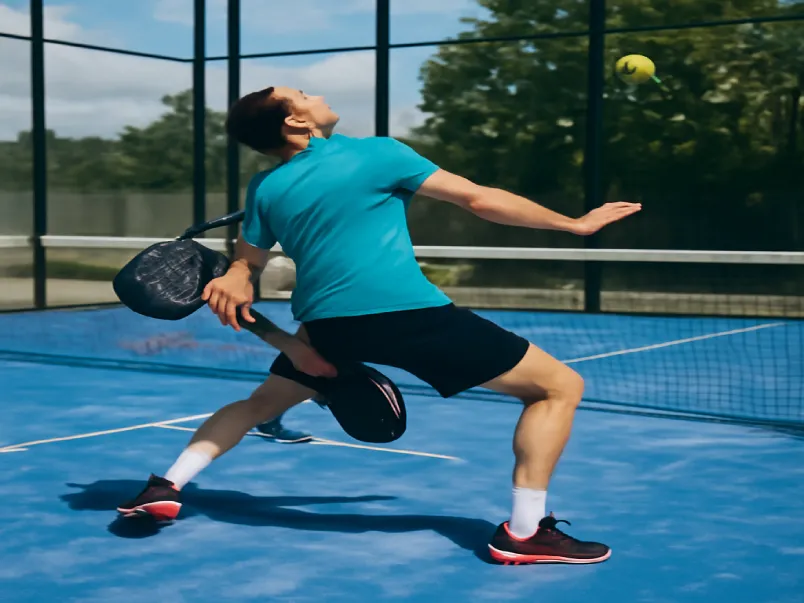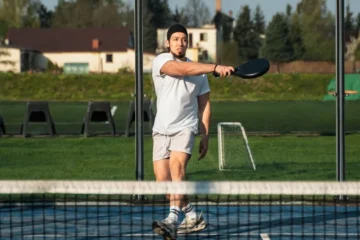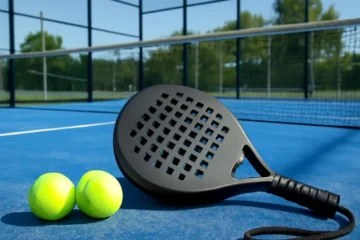Padel is a sport where strategy, finesse, and creativity converge. While technique and consistency are important, there’s something magical about pulling off a trick shot that leaves your opponents and spectators in awe. Trick shots aren’t just for show—they can be used to break the rhythm of your opponent, gain momentum in a match, and sometimes even win you a point out of nowhere. But how do you get from being a standard player to one who adds flair to the game? Let’s dive into the world of padel trick shots and explore how you can not only execute them but do so strategically for maximum impact.
I. The Art of the “Wow” Factor
Imagine a tense moment in a match. You’re on the backfoot, your opponent has been dominating the rallies, and the game seems to be slipping away. Just as all hope seems lost, you pull off a stunning shot, perhaps an improbable behind-the-back recovery or a perfectly executed tweener. The crowd gasps, your opponent is left stunned, and you’ve changed the tide of the match with a single, spectacular move.
Trick shots in padel are much more than just flashy maneuvers—they are the game’s equivalent of a “wow” moment. These shots are unexpected, creative, and require a high degree of skill and precision to pull off. While they certainly offer an opportunity to impress, trick shots are also strategic tools that can surprise your opponents, shift momentum, and boost your confidence.
In this article, we’ll look at some of the best trick shots in padel, how to perform them, and when to unleash them for maximum effect. But first, let’s establish the foundation—before you even attempt to add tricks to your game, mastering the fundamentals is essential.
II. Before You Begin: The Foundation of Flash
Master the Basics First
The foundation of any great trick shot begins with a solid understanding of the basics. If you haven’t yet mastered the standard padel shots—volleys, bandejas, viboras, and basic lobs—you’ll find it hard to pull off trick shots with precision and control. These shots are often the building blocks for more advanced moves.
For example, the bandeja (a defensive overhead shot) and vibora (a sharp, angled slice) are often used as setups for trick shots like the Bandeja Fake or the Backwall Boast. Without strong fundamentals, executing trick shots becomes impractical, not to mention frustrating.
Risk vs. Reward
Padel trick shots are high-risk, high-reward maneuvers. The payoff can be huge—either by catching your opponent off-guard or by turning the game around in a dramatic way. However, these shots are not foolproof and can sometimes backfire. Attempting a trick shot at the wrong moment, especially when the stakes are high or when you’re under pressure, can result in a costly unforced error.
Practice Makes Perfect
Like anything in padel, trick shots require practice. Don’t attempt them in a high-stakes match right away. Start by incorporating them into your training sessions, then gradually use them in friendly matches. The more you practice these shots in a low-pressure environment, the better your chances of pulling them off when it really matters.
III. The Trick Shot Arsenal: From Sneaky to Spectacular
Now that you understand the importance of mastering the basics and assessing the risk of trick shots, let’s break down some of the most popular shots you can add to your arsenal. For each trick shot, we’ll look at what it is, when to use it, and how to execute it effectively.
A. The Bandeja Fake (The “No-Look” Deception)
What it is:
The Bandeja Fake is a clever deception, where you set up for a powerful bandeja or vibora, only to change your plan at the last second. Instead of executing a deep, attacking shot, you gently tap the ball for a short, angled drop shot.
When to use it:
This trick shot works best when your opponent is expecting a deep, powerful shot from your setup. If you’ve conditioned them to anticipate a hard bandeja, pulling off a soft drop shot will catch them off guard as they retreat toward the back of the court.
How to do it:
- Prepare as if you’re about to hit a normal bandeja or vibora.
- Keep your body motion and backswing identical to what your opponent expects.
- As the ball approaches, loosen your grip on the racket and use your wrist to soften the shot.
- At the last moment, gently block the ball into an empty corner or side of the court, placing it just out of reach of your opponent.
Pro Tip: The key to success is the delayed decision. If you can replicate the initial setup of a powerful shot but then execute a soft drop shot, your opponent will be caught off guard.
B. The Behind-the-Back (The Desperation Save)
What it is:
The Behind-the-Back shot is a flashy, desperation move used when the ball has passed you and you need to recover from a difficult position. You hit the ball behind your back, usually in an attempt to return a ball that has bounced off the back glass.
When to use it:
This shot is typically used as a last resort when you’re out of position, and the ball is already behind you. It’s a recovery shot rather than an offensive one.
How to do it:
- Turn quickly to face the ball and let it rebound off the back glass.
- Swing your racket behind your back in a controlled arc, making contact with the ball.
- Aim to hit a high defensive lob that will allow you and your partner time to regain your position.
Pro Tip: This shot is more about feel than precision. Focus on solid contact and getting the ball back into play, rather than perfect placement.
C. The Tweener / Through-the-Legs (The Crowd-Pleaser)
What it is:
The Tweener, or Through-the-Legs shot, is a spectacle that always excites the crowd. It’s performed when you hit the ball between your legs while facing away from the net.
When to use it:
Similar to the behind-the-back shot, the tweener is often used when you’re chasing down a lob that has gone over your head. However, the tweener is slightly more controlled and can be used both defensively and offensively.
How to do it:
- Position yourself to chase the ball down so that it’s in line with your body.
- Bend your knees and spread your legs to create a “window” to hit through.
- Swing your racket through your legs and make contact with the ball, sending it back over your head.
Pro Tip: The footwork and body positioning are key to a successful tweener. Start by practicing the movement without a ball to get the timing and balance just right.
D. The Backwall Boast (The Ultimate Deception)
What it is:
The Backwall Boast is an incredibly deceptive shot, where you let the ball rebound off the back glass and then use a soft cut to hit the ball off the side wall, creating an impossible angle for your opponents.
When to use it:
This shot is most effective when your opponents are expecting a simple cross-court or lob return, but you have a high, bouncing ball from the back wall. It can completely throw them off balance and catch them by surprise.
How to do it:
- Let the ball rebound off the back glass.
- Instead of a normal swing, open the racket face and use a gentle cut motion.
- Aim for the side wall, so the ball travels diagonally toward the opposite corner of the court.
Pro Tip: The key to this shot is the softness of the contact. The more delicately you hit the ball, the more effective and deceptive it becomes.
IV. When to Unleash Your Trick Shots (Strategy)
Knowing how to pull off trick shots is only half the battle. The other half is knowing when to unleash them for maximum effect. Here are some strategic guidelines:
For Surprise
Trick shots are excellent for breaking an opponent’s rhythm, especially when they’re in a groove. Catching them off-guard with an unexpected shot can force them to lose focus and give you an edge in the match.
For Momentum
A spectacular trick shot can energize not only yourself but also your partner. If you’re in a tight match, executing a flashy shot can boost your confidence and create a momentum shift in your favor.
When You’re Well Ahead
If you’re comfortably ahead in a match, it’s the perfect time to experiment with trick shots. You have room to take risks without putting the outcome of the match in jeopardy.
When to Avoid Them
Avoid using trick shots when you’re struggling with consistency or when the match is on the line (such as match point). Also, avoid them against opponents who thrive on chaos and unforced errors—trick shots in such situations could end up giving away points unnecessarily.
V. Conclusion: Have Fun and Play Smart
In conclusion, trick shots in padel aren’t just about showboating. They are a blend of creativity, skill, and strategy that can give you a tactical advantage when used at the right moment. Mastering these shots takes practice, but it’s also about having fun and experimenting with your game. Remember, the journey to perfecting these shots is what makes padel so enjoyable. So, don’t be afraid to try, fail, and try again. The “wow” factor is within your reach!
FAQ (Frequently Asked Questions)
1. What are trick shots in padel?
Trick shots in padel are creative, high-difficulty shots that are designed to surprise your opponent. These shots are unexpected, visually impressive, and often require advanced technique. They include moves like the behind-the-back shot, tweener (through-the-legs), and bandeja fake.
2. How can I improve my trick shots in padel?
To improve your trick shots in padel, start by mastering the basic shots such as volleys, bandeja, vibora, and lobs. Practice your footwork, body positioning, and timing in a low-pressure environment. Once you’re comfortable, gradually introduce trick shots in friendly games or training sessions.
3. When is the best time to use trick shots in a match?
Trick shots are best used when you want to surprise your opponent, break their rhythm, or create momentum for your team. It’s also ideal to use them when you’re comfortably ahead in a match. Avoid using them when you’re under pressure, such as on match point or when consistency is more critical than creativity.
4. Are trick shots in padel risky?
Yes, trick shots in padel can be high-risk moves because they often require precise execution. If used incorrectly, they may result in an unforced error, giving your opponent a free point. However, when used strategically, they can disrupt your opponent’s game and turn the tide in your favor.
5. Can trick shots improve my overall game?
Absolutely! Trick shots not only add excitement and creativity to your game but also enhance your overall skills, such as timing, touch, and positioning. Mastering trick shots will increase your confidence and allow you to surprise your opponents in crucial moments.




